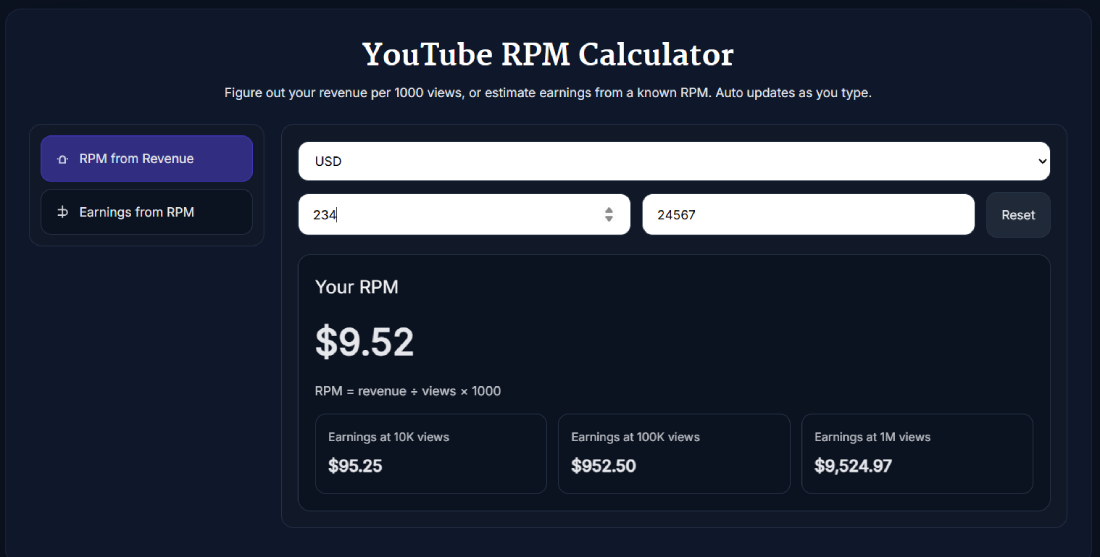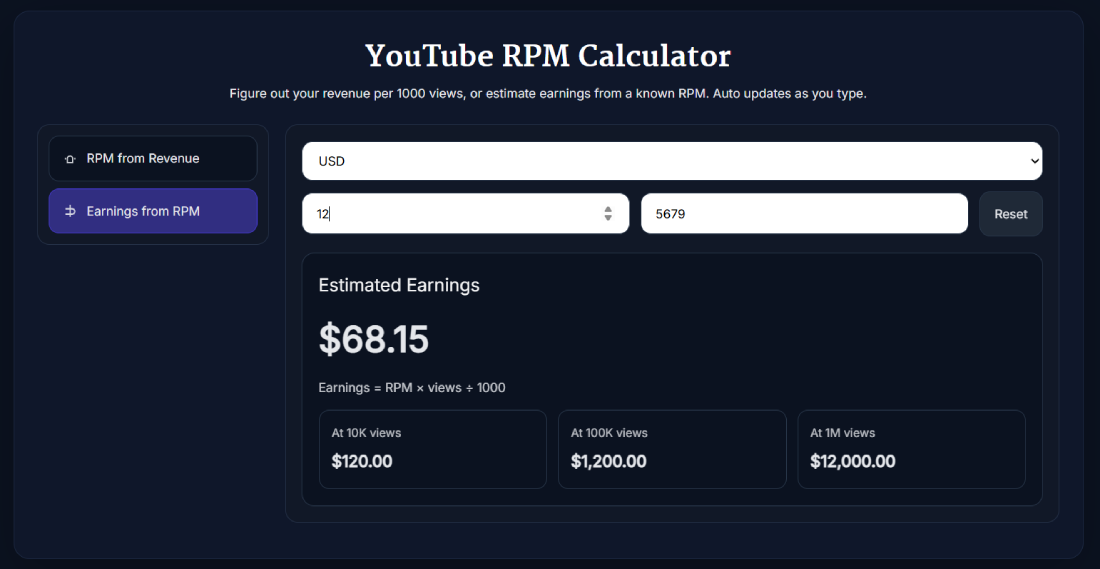YouTube RPM Calculator
Figure out your revenue per 1000 views, or estimate earnings from a known RPM. Auto updates as you type.
Your RPM
Estimated Earnings
The YouTube RPM Calculator instantly shows your revenue per 1,000 views or estimates your earnings from a known RPM. Just type your values, pick a currency, and results appear live—no extra clicks needed.
What the YouTube RPM Calculator Does
The calculator translates your YouTube analytics into plain revenue insights. You can either work out your RPM from past revenue and view data, or flip it to forecast potential earnings from a known RPM. Results update live, with mini-cards showing benchmarks at 10K, 100K, and 1M views.
The interface is split into two clear tabs: “RPM from Revenue” and “Earnings from RPM.” Each tab includes a currency selector, two simple input fields, and a Reset button. The output box displays RPM or estimated earnings in bold, so you don’t waste time doing the math manually.
Key Features for Revenue Planning
This tool was built to make planning easier for creators who don’t want to wrestle with spreadsheets.
- Two modes – Calculate RPM from revenue, or estimate earnings from RPM.
- Currency selector – Supports USD, INR, EUR, GBP, AUD, and CAD with correct formatting.
- Auto-updating results – Outputs refresh instantly while you type.
- Quick benchmarks – Earnings displayed for 10K, 100K, and 1M views.
- Reset function – Clear fields instantly to test new scenarios.
- Mobile-friendly layout – Works seamlessly on smaller screens.
- Browser-based – No logins, no data storage, no complexity.
- Growth forecast support – Helps tie subscriber tracker milestones to revenue goals.
How to Use YouTube RPM Calculator
Getting results is quick because the design mirrors a creator’s workflow.
- Pick your mode from the left panel: RPM from Revenue or Earnings from RPM.
- Select your currency from the dropdown.
- Enter your revenue and views (or RPM and views, depending on mode).
- See the RPM or estimated earnings update instantly in the result box.
- Review the mini-cards to compare projections at 10K, 100K, and 1M views.
- Use the Reset button to clear values and try new numbers.


Benefits of Using YouTube RPM Calculator
The real benefit is clarity. Instead of juggling spreadsheets or guessing with rough math, you get clean numbers instantly.
- Understand how much you actually earn per 1,000 views.
- Forecast revenue tied to your subscriber growth forecast.
- Spot month-to-month monetization changes without wasting time.
- Plan sponsorship conversations with reliable numbers.
- Use the mini-cards as a milestone counter when setting goals.
- Compare different RPMs for Shorts, live streams, or long videos.
- Budget production costs more confidently.
Real Example of Using the Tool
Take a creator who earned $234 from 24,567 views. After entering these values in the RPM from Revenue mode with USD selected, the tool instantly shows an RPM of $9.52. The mini-cards reveal $95.25 at 10K views, $952.50 at 100K, and $9,524.97 at 1M.
If that same creator switches to Earnings from RPM and inputs RPM of 12 with 5,679 views, the output box shows estimated earnings of $68.15. The mini-cards project $120 at 10K, $1,200 at 100K, and $12,000 at 1M. In a single glance, both past efficiency and future forecasts become clear.
Pro Tips for Getting the Best Results with YouTube RPM Calculator
This calculator is accurate, but your approach makes the difference.
- Always match revenue and views from the same timeframe.
- Run separate scenarios for Shorts versus long-form videos.
- Expect seasonal shifts: Q4 often spikes, January tends to dip.
- Compare international traffic segments to see CPM effects.
- Test creative changes like thumbnails and re-check RPM.
- Pair with related tools like the YouTube Tag Generator or Hashtag Extractor for deeper insights.
- Connect outputs with your subscriber tracker to keep milestone goals realistic.
- Re-calculate weekly as part of your content review routine.
FAQ
How accurate is the YouTube RPM Calculator?
The math is precise because it uses the standard formula: RPM = revenue ÷ views × 1000. As long as your inputs are accurate and cover the same time period, the results are trustworthy. Since outputs refresh live, you’ll spot any data entry errors immediately.
Does the tool work for any currency?
Yes. It supports USD, INR, EUR, GBP, AUD, and CAD. Whichever option you pick, the tool formats results properly. It’s best to match the calculator’s currency with your YouTube payout currency so your planning remains consistent.
Can I use it to forecast monthly earnings?
That’s one of its strongest uses. In the “Earnings from RPM” tab, enter your average RPM and target monthly views. The tool instantly displays your estimated revenue, along with mini-cards that scale projections at 10K, 100K, and 1M views.
Why does my RPM change month to month?
RPM is affected by factors like seasonality, advertiser demand, viewer geography, and content type. For instance, finance content often earns higher RPM than general entertainment. Seasonal peaks like Q4 can raise RPM, while January usually dips. The calculator helps track those fluctuations in real time.
What’s the difference between RPM and CPM?
CPM reflects what advertisers pay per 1,000 ad impressions. RPM reflects what creators actually earn per 1,000 views after YouTube’s cut and multiple monetization types are factored in. For creators planning revenue, RPM is the more reliable metric.
What is considered a “good” RPM on YouTube?
It depends on niche and audience location. Some channels see $1–$5 early on, while finance, software, or education can pull $10+ RPM. Instead of chasing averages, use this calculator to track your personal baseline and focus on incremental improvements.
How can I increase my RPM?
You can experiment with longer videos that support mid-rolls, optimize thumbnails for higher CTR, and target higher-value audiences. Improvements in watch time also help. After testing, re-calculate your numbers in the tool to measure the impact.
Does the calculator store my data?
No. It runs entirely in your browser. Inputs vanish once you reset or refresh the page, so your analytics remain private. There’s no login or server storage involved.
Can Shorts generate meaningful RPM?
Yes, but it varies a lot. Shorts monetization is still evolving, and RPM can be volatile. If Shorts are central to your channel, calculate them separately from long-form content so your revenue forecasts remain accurate.
Which other tools pair best with this calculator?
The YouTube Thumbnail Downloader, YouTube Tag Generator, YouTube Hashtag Extractor, and YouTube Channel ID Finder all complement it. They help optimize growth, while this calculator confirms the financial side.
What affects RPM more, niche or geography?
Both matter, but niche usually sets the ceiling. A finance video in the U.S. might yield $15 RPM, while general entertainment Shorts in a lower-value region could be under $1. Use YouTube Analytics to track audience shifts, then plug the numbers into this calculator for forecasts.
